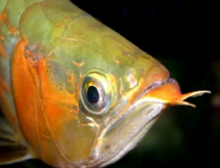Description: The Asian arowana is a prehistoric freshwater fish that has a long, narrow and flat body. The belly is a sharp ridge with large, thick scales. At the end of the lower jaw, there is a pair of large barbels. The mouth is extremely wide. The arowana has many colors such as gold, red, and green. The arowana is often called “dragon fish” because of its enormous scales and long, whisker-like chin barbels. When it glides gracefully through the water, its pectoral fins often spread out, resembling a dragon in full flight. The oriental dragon is a symbol of good luck, strength and power in many cultures and is said to ward off evil.
Size: The Asian arowana can reach 36 inches (91 cm) in length, but are usually smaller.
Behavior: Arowanas are usually found alone or in small groups in the wild where they are extremely territorial and aggressively defend their space.
Diet: This carnivorous animal is predatory in the wild, where they surface feed, hunting in shallow, often shaded areas. They are noted for their ability to leap out of the water for food flying overhead or hanging on vegetation above the surface, such as insects, frogs, spiders, lizards, birds, bats, etc.
Reproduction: Egg laying is very special to this paternal mouthbrooder. The male keeps the eggs in his mouth for a month before the eggs hatch out. The fries then remain in the mouth for another two to three months. One of the sexual differences is the males have wider and deeper mouths for incubating purposes.
moving streams that are often a little murky, acidic with a rocky, sandy bottom and lots of weedy plants. As the name implies, they are found in Asia: Indonesia, Malaysia, Thailand, Cambodia and Vietnam.
Status: Even though this species is known to live up to 60 years in captivity, perhaps longer in the wild, it is endangered in the wild, and is listed under CITES (Convention on International Trade in Endangered Species) Appendix I, meaning that international trade is tightly restricted. Major threats are its popularity in the aquarium industry and declining habitats.



